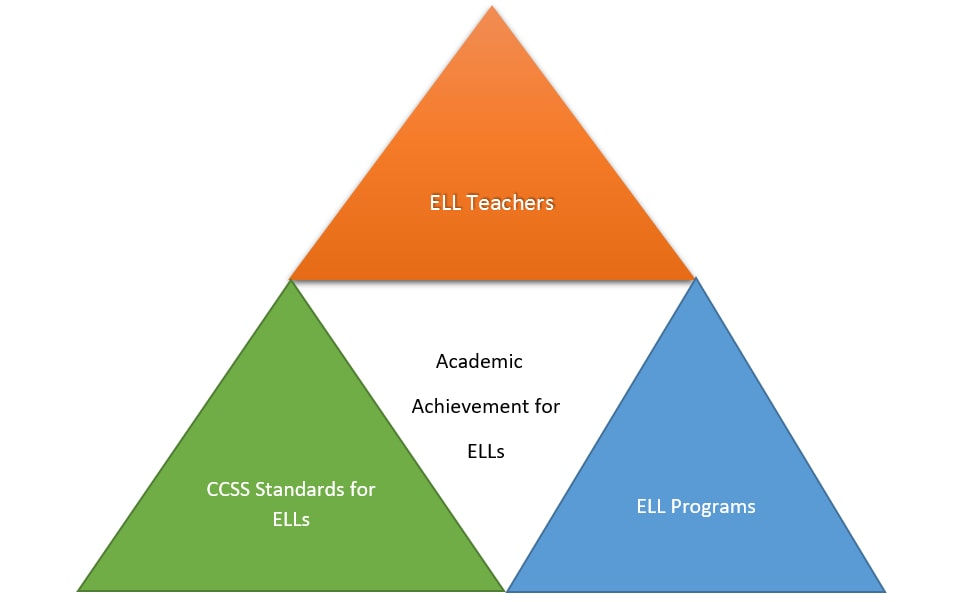ELL Programs
- Jyldyz Byler

- Oct 21, 2016
- 4 min read
Critical Components for Effective ELL Education
To provide effective education for ELL students, teachers work within a system that has three critical components: teachers, standards, and assessment. These components always interact and influence each other, forming a triangle of interaction that affects to ELL students’ academic achievement. For ELLs effectively learning all three components must be equally developed. If one component is inattention the other two will not succeed.

ELL teachers should have the knowledge, skills, and experience to provide instructions effectively. ELL teachers should know Professional Teaching Standards so they can apply that knowledge in the classroom. Also, teacher should be able design their instructions for ELLs around CCSS standards, that outline content for which students are responsible.
The English Language Learner program is a program that uses only English as the instructional language for eligible students and enables such students to achieve English proficiency and academic mastery of subject matter content and higher order skills including critical thinking, so as to meet appropriate grade promotion and graduation requirements. Students are exposed to a learning environment in which they participate actively. Instruction is always presented in a meaningful context and it is categorized by three phases:
ELL 1: Beginner
ELL 2: Intermediate
ELL 3: Advanced
These phases are based on a child's English Proficiency. Children begin their second language acquisition in the schools by starting somewhere in one of these phases. The outcome of this instructional process must enable children to listen, comprehend, speak, read, write, and analyze and think in English.
The Common Core Standard define knowledge in English language arts and mathematics that have to be effectively taught for all students, so students can succeeds academically in different programs. The Common Core Standards goal is to provide more consistent exposure to materials and learning experiences through curriculum and instruction among other support for student learning. Common Core Standards provide specific standards in language art and math for grades k-8. Also, Common Core Standards insure continuity across grade levels.
Two ELL programs that go well with the standards above and that I would use in my classroom.
PULL-OUT ELL
“Pull-out ELL is a program model that allows ELL students to spend most of the day in general education
classrooms. ELL students are taken out of their classes for one or two periods a day to receive ELL instruction in smaller class sizes with students of similar proficiency levels. Ideally, the ELL teacher aligns his or her teaching to the ELL standards and scaffolds instruction that will enable the students to perform successfully in the general education classroom. ELL teachers should also incorporate intensive vocabulary and grammar instruction to enable their students to access academic content. Two of the disadvantages are that pulling students out and walking them to a new room can waste instructional time and that students will miss class work while they are gone. It is extremely important for the ELL teacher to work closely with classroom teachers to ensure that the students are not being graded down for missed work. Collaboration should occur between he ELL teacher and the regular education teacher to achieve maximum student success. It is important that ELL teachers are using an oral language development program during their pull out time. This will enhance students' language proficiency. (n.d.)”
PUSH-IN ELL
“A Push-in ELL program is a program built off the idea that pulling students out of their classrooms is an inefficient use of time and can prevent students from fully integrating into the classroom. Push-in means that the ELL teacher goes into the classroom to service students for the mandated time. Ideally, the ELL teacher and the classroom teacher will work together to plan to make the most of the time.
There are three positive ways for ELL teachers to Push-in.
1. Team Teaching:
There are several ways for the ELL teacher to work within the classroom. One way is to team teach. The ELL teacher and the regular classroom teacher will take turns delivering lessons with the ELL teacher focusing on providing scaffolding and addressing more basic skills. The ELL teacher also provides ideas and materials for differentiating and scaffolding classroom teacher written lessons. In this model, the ELL teacher is the expert on making the content and material accessible to all learners.
2. Small-Group Instruction
A second option is for the ELL teacher to pull a small group during the independent work time to reinforce or re-teach a skill. This can also be a time to teach more basic language skill or grammar points. This is an ideal model, provided the classroom teacher has a consistent schedule for independent work time. It is not a time to help students finish worksheets. The ELL teacher should be teaching and supporting student learning through language.
3. One-on-One Instruction
A third way for the ELL teacher to service the students is to sit with the students one-on-one to assess reading and writing skills during independent reading time or work time. This model is less efficient, but can work for small ELL populations. The skills addressed should align to the curriculum and goals based on English Language Arts (ELA) objectives. “(n.d.)
Reference
English Language Learners / ELL Programs. (n.d.). Retrieved October 21, 2016, from http://www.washoeschools.net/Page/1933
Implementing the Common Core State Standards for English ... (n.d.). Retrieved October 21, 2016, from http://www.tesol.org/docs/default-source/advocacy/ccss_convening_final-8-15-13.pdf?sfvrsn=4
Organization of a Pull-Out Lesson - YouTube. (n.d.). Retrieved October 21, 2016, from http://www.youtube.com/watch?v=4O68mSZ3gEM
Classroom Observation Strategies: Peer Observation - YouTube. (n.d.). Retrieved October 21, 2016, from http://www.youtube.com/watch?v=c_W6tb35r3M
![endif]--




Comments